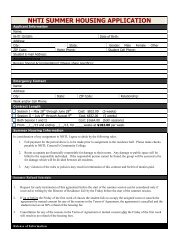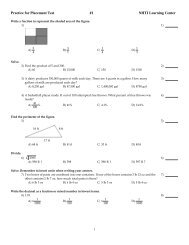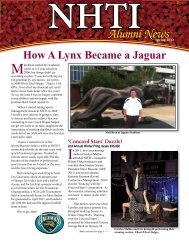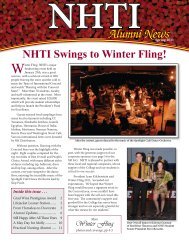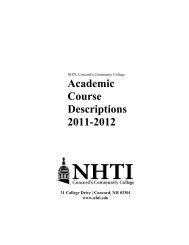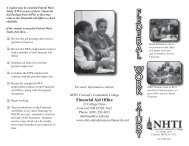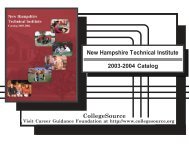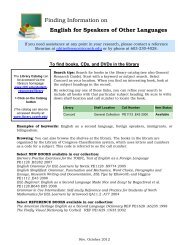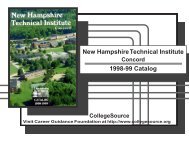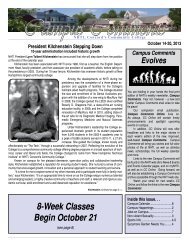Catalog 05-06 - NHTI - Concord's Community College
Catalog 05-06 - NHTI - Concord's Community College
Catalog 05-06 - NHTI - Concord's Community College
- No tags were found...
Create successful ePaper yourself
Turn your PDF publications into a flip-book with our unique Google optimized e-Paper software.
Copyright & Disclaimer Information: Copyright © 1994, 1995, 1996, 1997, 1998, 1999, 2000, 2001, 2002, 2003, 2004, 20<strong>05</strong>, 20<strong>06</strong>, 2007. <strong>College</strong>Source®, Inc. and Career Guidance Foundation. <strong>College</strong>Source® digital catalogs are derivative works owned and copyrighted by <strong>College</strong>Source®, Inc. and Career Guidance Foundation. <strong>Catalog</strong> content is owned and copyrighted by the appropriate school. While <strong>College</strong>Source®, Inc. and Career Guidance Foundation provides information as a service to the public, copyright is retained on all digital catalogs.Copyright & Disclaimer Information: Copyright © 1994, 1995, 1996, 1997, 1998, 1999, 2000, 2001, 2002, 2003, 2004, 20<strong>05</strong>, 20<strong>06</strong>, 2007. <strong>College</strong>Source®, Inc. and Career Guidance Foundation. <strong>College</strong>Source® digital catalogs are derivative works owned and copyrighted by <strong>College</strong>Source®, Inc. and Career Guidance Foundation. <strong>Catalog</strong> content is owned and copyrighted by the appropriate school. While <strong>College</strong>Source®, Inc. and Career Guidance Foundation provides information as a service to the public, copyright is retained on all digital catalogs.Course Descriptionswell as techniques to improve productivity. This course does not meet requirementsfor MET/MFT programs. (Prerequisite: CD 101)CD 103 CAD III 1-3-2This course is a continuation CD 101 and CD 102. Emphasis is placed on3-D parametric solid modeling using Autodesk Mechanical Desktop. Studentwill develop skills and utilize techniques to produce geometric profilesthat serve as a database for the production of 3-D models, workingdrawings, bill of materials and exploded views of assembled models. Thiscourse does not meet requirements for MET/MFT programs. (Prerequisites: CD101 and CD 102)Computer Engineering TechnologyIn addition to listed prerequisites, students must earn grades of “C-“ or higher ineach course to progress in the program.CP 107 Introduction to Programming with C++ 2-3-3Introduces the student to program design using the language C++. Noprior knowledge of programming is assumed. Focuses on effective structureddesign of code with variables, decisions, loops, functions, arraysand introduction of pointers. Use of professional programming designapproaches and coding style will be used in laboratory assignments. Completionof this course provides the programming design skills to continue onwith the study of the language C++ or other computer languages. A gradeof C- or higher must be achieved to meet the prerequisite criteria for subsequentmajor field courses.CP 112 Embedded Systems Programming 3-3-4Microprocessor architecture, instruction sets, hardware interfacing andapplications are covered with emphasis on machine and assembly languageprogramming. Integrated hardware/software development environmentssupporting both high-level and assembly language program developmentare utilized. Laboratory exercises explore microcontroller systemslevel applications including parallel and serial data transfer, dataacquisition, and real-time applications with digital and analog input andoutput signals. Advanced topics may include an introduction to controland embedded micro-systems applications. (Prerequisites: CP 107, EL101 and EL 115; corequisite: CP 215; or permission of department headof Computer Engineering Technology)CP 215 Integrated Circuits and Interfacing 3-3-4For CPET and other NON-EET majors, this course supplements EL 115(Digital Fundamentals) with basic linear and interface electronics. Topicscovered include simple power supplies, op-amps, stepper motors, A/D &D/A conversion, interfacing a computer bus, parallel and serial ports.Advanced digital topics such as synchronous logic and programmablelogic devices will also be covered. The labs demonstrate real world implementationof otherwise abstract academic concepts. Fluency with theuse of test equipment and debugging skills will also be stressed in thelaboratory environment. (Prerequisites: EL 101 and EL 115 or permissionof department head of Computer Engineering Technology)CP 222 Data Communications & Internetworking 3-3-4This course provides the student knowledge and skills in a wide range oftopics covering data communications, packet transmission and theInternet. Data communications subtopics include transmission media,serial communications, error detection & correction schemes, data securityand signal processing required for long distance communications.Packet transmission subtopics include local area networks, hardware addressing,LAN building blocks, and wide area networks. Internetworkingsubtopics include TCP/IP communication stack, ISO 7-layer communicationstack, network addressing, Internet protocol (IP), address resolutionprotocol (ARP), Internet control message protocol (ICMP), IP routingprotocols, transport control protocol (TCP), user datagram protocol(UDP), and client-server API. (Prerequisites: CP 107 and CP 235;corequisites: CP 240, CP 252 recommended; or permission of departmenthead of Computer Engineering Technology)CP 235 Algorithms With Object Oriented Programming 3-3-4This course focuses on the development, implementation and analysis ofalgorithms developed with object oriented design. Object oriented programming(OOP) techniques will be used to solve algorithms such asstacks, queues and linked lists. Concepts such as priority ranked data andobject containers as well as circular queues will be covered. Sorting, datamanipulation and retrieval will be covered. Languages which supportOOP will be used as the learning method. Both C++ and Java will beused. This course covers intermediate and advanced topics with extensivehands on programming. Key OOP foundation capabilities of data abstractions,inheritance and polymorphism will be covered. Topics in C++specifically covered will be pointers, operator overloading and multipleinheritance. (Prerequisite: CP 107; or permission of department head ofComputer Engineering Technology)CP 240 Programming for Windows Operating Systems 3-3-4Microsoft.Net Framework programming will be covered from WindowApplications to full utilization of the Internet. Microsoft Visual Studio.Netwith its intergraded development environment will be studied and utilized.The programming languages will be Visual Basic.Net and C# withemphasis on C#. The course will use programming techniques to understandthe functionality of the operating system and the .Net foundationintegration with the Internet. Internet usage will involve developing webpages using Web Forms by using ASP.Net. Connection and use of databaseswill use ADO.Net. Web Services for distributed applications on theInternet will also be covered. Advanced features of the language C# willbe reviewed. Experience will be gained using extensive hands-on laboratoryassignments. (Prerequisites: CP 107 and CP 235 or permission ofdepartment head of Computer Engineering Technology based on havingintroductory programming skills with languages such as Java, C++ orclassic Visual Basic)CP 252 Networking and Internet Technologies 3-3-4This course provides the student knowledge and skills in a diverse rangeof topics including structured query language (SQL), client-server programming,selected internet applications and LAMP (Linux, Apache,MySQL and PHP). SQL subtopics include relational database concepts,the SQL language and relational database design. Client server programmingis studied in C++ using socket APIs and Java using socket classes.Selected internet applications include domain name system (DNS), hypertexttransfer protocol (HTTP) and file transfer protocol (FTP). LAMPtopics include a Linux overview, Apache web server configuration, dynamicweb pages using PHP and MySQL relational database. Each studentis also required to define, implement, demonstrate and present anetworking project during the last several weeks of the course. (Prerequisites:CP 107 and CP 235 or permission of department head of ComputerEngineering Technology)CP 260 Computer Real Time Interfacing 3-3-4Interfacing computers to the outside world is the focus of this course.Computers are commonly used to gather data and to control processessuch as medical equipment, research projects and manufacturing. Thecourse content focuses on practical real time (fast response) andmultithreaded programming techniques used in interfacing of computerinputs and outputs. The course is divided into two major parts. First, aprogrammable logic controller industrial computer using the languagerelay ladder logic (Boolean algebra based) is used to teach the fundamentalsof real time control. The second part uses multithreading programmingtechniques using optionally Java or C#. Animation concepts areused to augment the multithreaded aspects, both 2D and 3D. The finalproject is presented in class. (Prerequisite: CP 107; corequisite: CP 235;or permission of department head of Computer Engineering Technologybased on introductory knowledge of C++ or Java)CP 301 Computer Project Definition 1-0-1Students will elect this course as a first phase to Computer Project CP303. During this course a student selects a project which is either providedby an industrial sponsor or chosen by the student. The selections aremade with the guidance and approval of the instructor. The student will93



